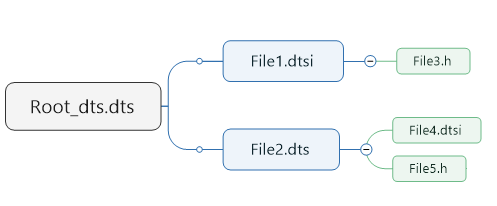獨立編譯裝置樹的方法 多檔案 多dts依賴
阿新 • • 發佈:2018-12-17
通常將裝置樹原始碼(dts/dtsi)編譯成裝置樹二進位制檔案(dtb)可以使用DTC(Device Tree Compiler)工具編譯。
- 單檔案編譯
對於單檔案的dts,可以採用下面的命令:
# dtc命令使用方法見文末
dtc -O dtb -b 0 -o [dest_dtb_file] [src_dts_file]
將src_dts_file編譯成dest_dtb_file裝置樹二進位制檔案。
- 多檔案編譯
對於有#include包含關係、巨集定義的dts檔案,直接採用以上的方法將會出現#include相關的語法錯誤。 DTC本身不支援#include語法,其正確語法為/include/。
如將以下dts(沒有巨集定義)
#include "child_file.dtsi"
#include "child_file_common.dtsi"
改為
/include/ "child_file.dtsi"
/include/ "child_file_common.dtsi"
即可通過編譯。
對於以下稍微複雜一點(包含#include,巨集,*.h等)的裝置樹,以上的方法不免有些笨拙。

由於“#include”“巨集”等都是C的特徵,因此可以使用CPP(C Preprocessor)命令對dts原始檔進行處理,完成檔案包含與巨集置換的工作。
# cpp的使用方法較長就不列出來了,可以自己man一下。 使用以上命令將所有的*.dts、*.dtsi、*.h轉換至臨時*.dts中,然後再使用單檔案編譯的方法編譯臨時*.dts,生成最終的dtb。
將上面的操作寫成指令碼(dts2dtb.sh
#/bin/bash
#set -vx
device="your_device_name"
src_dts=$device.dts
tmp_dts=$device.tmp.dts
dst_dtb=$device.dtb
cpp -nostdinc -I. -undef -x assembler-with-cpp $src_dts > $tmp_dts
dtc -O dtb -b 0 -o $dst_dtb $tmp_dts
rm $tmp_dts
使用:
修改your_device_name為你要編譯的裝置樹名稱,拷貝所有相關的裝置樹原始檔至指令碼所在目錄,執行。
dtc使用方法:
NAME
dtc - Device Tree Compiler
SYNOPSIS
/usr/bin/dtc [options] <input file>
DESCRIPTION
Device Tree Compiler, dtc, takes as input a device-tree in a given format and outputs a
device-tree in another format for booting kernels on embedded systems. Typically, the input
format is "dts", a human readable source format, and creates a "dtb", or binary format as
output.
OPTIONS
-h Display help text.
-q Quiet:
-q - Suppress warnings.
-qq - Suppress errors.
-qqq - Suppress all.
-I <input format>
Input formats are:
dts - device tree source text
dtb - device tree blob
fs - /proc/device-tree style directory
-o <output file>
Dump the result into a file, instead of stdout.
-O <output format>
Output formats are:
dts - device tree source text
dtb - device tree blob
asm - assembler source
-V <output version>
Blob version to produce. The default is 17 (only relevant for dtb and asm output).
-d <output dependency file>
-R <number>
Make space for <number> reserve map entries (only relevant for dtb and asm output).
-S <bytes>
Make the blob at least <bytes> long (extra space).
-p <bytes>
Add padding to the blob of <bytes> long (extra space)
-b <number>
Set the physical boot CPU.
-f
Force - try to produce output even if the input tree has errors.
-s
Sort nodes and properties before outputting (only useful for comparing trees)
-v Print DTC version and exit.
-H <phandle format>
phandle formats are:
legacy - "linux,phandle" properties only
epapr - "phandle" properties only
both - Both "linux,phandle" and "phandle" properties
